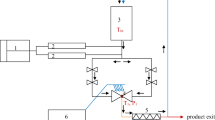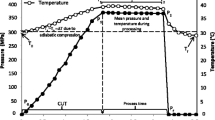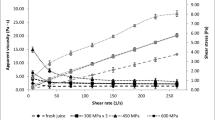Abstract
Sea buckthorn berries juice is a nutritious beverage, rich in vitamin C and carotenoids with high antioxidant activity. The main requirements for a freshly squeezed sea buckthorn juice production are the cloud stability and antioxidant activity retention after processing. Appropriate process technologies and conditions have to be applied in order to inactivate pectin methyl esterase (PME), responsible for cloud loss, while maintaining the nutritional characteristics and antioxidant activity of the juice. The objectives of the present work were to study and model the effect of thermal treatment and high pressure (HP) processing on the inactivation kinetics of endogenous PME and on total antioxidant activity alteration. Thermal treatment significantly affected PME inactivation and residual antioxidant activity. Processing even at mild process conditions (60 °C for 1 min) resulted in 2.5-fold antioxidant activity reduction and 50 % PME inactivation compared to untreated sample. Pressure and temperature acted synergistically for PME inactivation that followed first-order kinetics with a residual PME activity at all pressure–temperature combinations used (200–600 MPa and 25–35 °C). The effect of temperature and pressure on the inactivation rate constants was expressed through the activation energy and activation volume, respectively. Values of 163 kJ/mol and −17 mL/mol at reference pressure of 600 MPa and reference temperature of 35 °C were estimated, respectively. Antioxidant activity of the samples was expressed through the determination of the effective concentration (EC50). A slight increase in sea buckthorn antioxidant activity when applying pressures (200–600 MPa) at ambient temperature (25 °C) was observed compared to the corresponding value of untreated juice. Processing at higher temperatures did not significantly alter the total antioxidant activity of sea buckthorn juice. For sample treated at 600 MPa–35 °C for 5 min, a 5 % reduction of total antioxidant activity was observed. These conditions are proposed as effective process conditions for sea buckthorn juice cold pasteurization, based on the higher antioxidant activity retention and simultaneous PME inactivation.





Similar content being viewed by others
References
Antolovich, M., Prenzler, P., Patsalides, E., McDonald, S., & Robards, K. (2002). Methods for testing antioxidant activity. Royal Society of Chemistry, 127, 183–198.
Balasubramaniam, V. M., Farkas, D., & Turek, E. J. (2008). Preserving foods through high-pressure processing. Food Technology, 62(11), 32–38.
Basak, S., & Ramaswamy, H. S. (1996). Ultra high pressure treatment of orange juice: a kinetic study on deactivation of pectin methyl esterase. Food Research International, 29, 601–607.
Beveridge, T., & Harrison, J. E. (2001). Microscopic structural components of sea buckthorn (H. rhamnoides. L) juice prepared by centrifugation. Lebensmittel-Wissenschaft und -Technologie, 34, 458–461.
Boulekou, S., Katsaros, G., & Taoukis, P. (2010). Inactivation kinetics of peach pulp pectin methylesterase as a function of high hydrostatic pressure and temperature process conditions. Food and Bioprocess Technology, 3(5), 699–706.
Brand-Williams, W., Cuvelier, M. E., & Berset, C. (1995). Use of a free radical method to evaluate antioxidant activity. Food Science and Technology, 28, 25–30.
Calligaris, S., Foschia, M., Bartolomeoli, I., Maifreni, M., & Manzocco, L. (2012). Study on the applicability of high-pressure homogenization for the production of banana juices. LWT - Food Science and Technology, 45(1), 117–121.
Cameron, R. G., Baker, R. A., & Grohmann, K. (1996). Citrus tissue extracts affect juice cloud stability. Journal of Food Science, 62, 242–245.
Deepak, D., Maikhuri, R. K., Rao, K. S., Lalit, K., Purohit, V. K., Manju, S., et al. (2007). Basic nutritional attributes of Uttarakhand Himalaya, India. Current Science, 92, 1148–1152.
Dewanto, X. W., Adom, K., & Liu, R. (2002). Thermal processing enhances the nutritional value of tomatoes by increasing the total antioxidant activity. Journal of Agricultural and Food Chemistry, 50(10), 3010–3014.
Goodner, J. K., Braddock, R. J., Parish, M. E., & Sims, C. A. (1999). Cloud stabilization of orange juice by high pressure processing. Journal of Food Science, 64, 699–700.
Guiavarc’h, Y., Segovia, O., Hendrickx, M., & Van Loey, A. (2005). Purification, characterization, thermal and high-pressure inactivation of a pectin methylesterase from white grapefruit (Citrus paradisi). Innovative Food Science and Emerging Technologies, 6(4), 363–371.
Guliyev, V. B., Gul, M., & Yildirim, A. (2004). Hippophae rhamnoides L.: chromatographic methods to determine chemical composition, use in traditional medicine and pharmacological effects. Journal of Chromatography B, 812(1–2), 291–307.
Gutzeit, D., Baleanu, G., Winterhalter, P., & Jerz, G. (2008). Vitamin C content in sea buckthorn berries (Hippophaë rhamnoides L. ssp. rhamnoides) and related products: a kinetic study on the storage stability and the determination of processing effects. Journal of Food Science, 73, C615–C620.
Hayashi, R. (1995). Use of high pressure in bioscience and in biotechnology. High pressure bioscience and biotechnology, vol. 13 (pp. 1–7). Amsterdam: Elsevier.
Hendrickx, M., & Knorr, D. (2002). Ultra high pressure treatment of foods. New York: Kluwer. Aspen food engineering series.
Katsaros, G., Tsevdou, M., Panagiotou, T., & Taoukis, P. (2010). Kinetic study of high pressure microbial and enzyme inactivation and selection of pasteurization conditions. International Journal of Food Science and Technology, 45(6), 1119–1129.
Kaur, C., & Kapoor, H. C. (2001). Antioxidants in fruits and vegetables. The millennium’s health. International Journal of Food Science and Technology, 33, 703–725.
Kimball, D. A. (1991). Citrus processing-quality control and technology (pp. 117–243). New York: Van Nostrand Reinhold.
Li, T. S. C. (2002). Product development of sea buckthorn. In J. Janick & A. Whipkey (Eds.), Trends in new crops and new uses (pp. 393–398). Alexandria: ASHS Press.
Li, T., & Schroeder, B. (1999). A growers guide to sea buckthorn. Available from Agriculture and Agri-Food Canada, PFRA Shelter Belt Centre, Indian Head, Sask.
Ly-Nguyen, B., Loey, A. M. V., Smout, C., Verlent, I., Duvetter, T., & Hendrickx, M. E. (2003). Effect of mild-heat and high-pressure processing on banana pectin methylesterase: a kinetic study. Journal of Agricultural and Food Chemistry, 51(27), 7974–7979.
Ly-Nguyen, B., Van Loey, A. M., Fachin, D., Smout, C., Verlent, I., Duvetter, T., Vu, S. T., & Hendrickx, M. E. (2002). Strawberry pectin methylesterase: Purification, characterization, thermal and high-pressure inactivation. Biotechnology progress, 18, 1447–1450.
Manea, I., & Buruleanu, L. (2009). Mathematical model for the evaluation of the sea-buckthorn juice preservation. Ovidius University Annals of Chemistry, 20(1), 83–86.
McInerney, J. K., Seccafien, C. A., Stewart, C. M., & Bird, A. R. (2007). Effects of high pressure processing on antioxidant activity, and total carotenoid content and availability, in vegetables. Innovative Food Science and Emerging Technologies, 8, 543–548.
Nanasombat, S., & Teckchuen, N. (2009). Antimicrobial, antioxidant and anticancer activities of Thai local vegetables. Journal of Medicinal Plants Research, 3, 443–449.
Odriozola-serrano, I., Soliva-fortuny, R., & Marti, O. (2009). Impact of high-intensity pulsed electric fields variables on vitamin C, anthocyanins and antioxidant capacity of strawberry juice. LWT - Food Science and Technology, 42, 93–100.
Oey, I., Lille, M., Van Loey, A., & Hendrickx, M. (2008). Effects of high pressure processing on colour, texture and flavour of fruit and vegetable based food products: a review. Trends in Food Science and Technology, 19, 320–328.
Patras, A., Brunton, N. P., Da Pieve, S., & Butler, F. (2009). Impact of high pressure processing on total antioxidant activity, phenolic, ascorbic acid, anthocyanin content and colour of strawberry and blackberry purees. Innovative Food Science and Emerging Technologies, 10, 308–313.
Plaza, L., Sánchez-moreno, C., De Ancos, B., & Elez-martínez, P. (2011). Carotenoid and flavanone content during refrigerated storage of orange juice processed by high-pressure, pulsed electric fields and low pasteurization. LWT - Food Science and Technology, 44(4), 834–839.
Polydera, A., Galanou, E., Stoforos, N., & Taoukis, P. (2004). Inactivation kinetics of pectin methylesterase of Greek Navel orange juice as a function of high hydrostatic pressure and temperature process conditions. Journal of Food Engineering, 62(3), 291–298.
Rouse, A. H., & Atkins, C. D. (1955). Pectinesterase and pectin in commercial citrus juices as determined by methods used at the Citrus Experiment Station. Florida University Agricultural Experiment Station Technology Bulletin, 570.
Sampedro, F., Geveke, D. J., Fan, X., & Zhang, H. Q. (2009). Effect of PEF, HHP and thermal treatment on PME inactivation and volatile compounds concentration of an orange juice–milk based beverage. Innovative Food Science and Emerging Technologies, 10(4), 463–469.
Shah, A. H., Ahmed, D., Sabir, M., Arif, S., Khaliq, I., & Batool, F. (2007). Biochemical and nutritional evaluations of sea buckthorn (Hippophae rhamnoides L. spp. Turkestanica) from different location of Pakistan. Pakistani Journal of Botany, 39, 2059–2065.
Sikora, E., Cieślik, E., Leszczyńska, T., Filipiak-Florkiewicz, A., & Pisulewski, P. M. (2008). The antioxidant activity of selected cruciferous vegetables subjected to aquathermal processing. Food Chemistry, 1(1), 55–59.
Tiitinen, K., Hakala, M., & Kallio, H. (2006). Headspace volatiles from frozen berries of sea buckthorn (Hippophae rhamnoides L.) varieties. European Food Research and Technology, 223, 455–460.
Tiitinen, K., Vahvaselka, M., Laakso, S., & Kallio, H. (2007). Malolactic fermentation in four varieties of sea buckthorn (Hippophae rhamnoides L.). European Food Research and Technology, 224, 725–732.
Van den Broeck, I., Ludikhuyze, L. R., Van Loey, A. M., & Hendrickx, M. E. (2000). Inactivation of orange pectinesterase by combined high-pressure and -temperature treatments: a kinetic study. Journal of Agricultural and Food Chemistry, 48(5), 1960–1970.
Vincze, I., Bányai-Stefanovits, É., & Vatai, G. (2007). Concentration of sea buckthorn (Hippophae rhamnoides L.) juice with membrane separation. Separation and Purification Technology, 57(3), 455–460.
Zheng, R. X., Xu, X. D., Tian, Z., & Yang, J. S. (2009). Chemical constituents from the fruits of Hippophae rhamnoides. Natural Product Research, 23, 1451–1456.
Acknowledgments
This research has been cofinanced by the European Union (European Social Fund—ESF) and Greek national funds through the Operational Program “Education and Lifelong Learning” of the National Strategic Reference Framework (NSRF)–Research Funding Program: Heracleitus II. Investing in knowledge society through the European Social Fund.
Author information
Authors and Affiliations
Corresponding author
Rights and permissions
About this article
Cite this article
Alexandrakis, Z., Kyriakopoulou, K., Katsaros, G. et al. Selection of Process Conditions for High Pressure Pasteurization of Sea Buckthorn Juice Retaining High Antioxidant Activity. Food Bioprocess Technol 7, 3226–3234 (2014). https://doi.org/10.1007/s11947-014-1299-5
Received:
Accepted:
Published:
Issue Date:
DOI: https://doi.org/10.1007/s11947-014-1299-5




